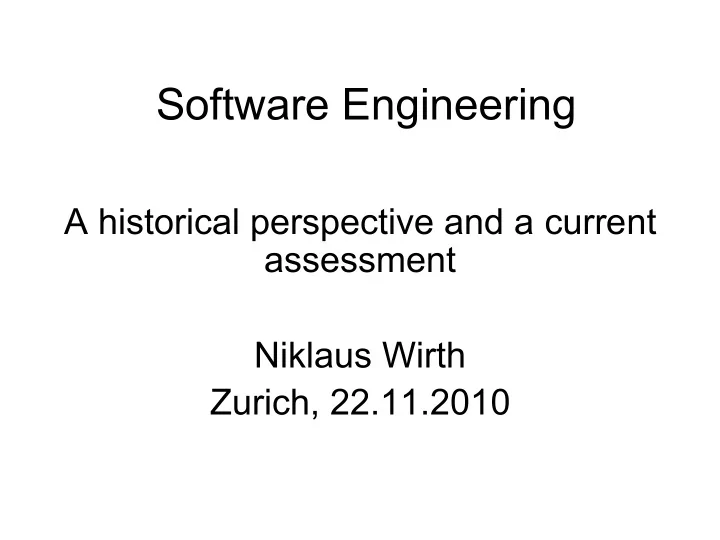

Software Engineering A historical perspective and a current assessment Niklaus Wirth Zurich, 22.11.2010
Early days 1960: Language and compiler Neliac Overriding property: A mess Extending language, fixing compiler bugs: Black art Missing a scientific basis Therefore a unique subject for scientific research The ESSENCE of SE: Cleaning the mess
How can you write “ correct ” programs, if there is no rigorous specification of your notation? Algol 60 appeared as an excellent starting point It provided structure, defined in a rigorous mathematical sense: Syntax Giving a strong impetus to methods of syntactic analysis
EBNF: The Syntax of Syntax • syntax = {rule}. • rule = ident “ := “ expression “ . ” . • expression = term { “ | ” term}. • term = factor {factor}. • factor = ident | string | “ ( “ expression ” ) ” | • “ [ “ expression ” ] ” | “ { “ expression ” } ” .
Semantics Syntax ok, but what about meaning? The dominant idea: Operational semantics Attach a meaning to each syntactic construct Semantic of each construct defined in terms of a short program, specified in a simpler language Garwick, Wirth: Euler Did not solve the problem, simply moved it down to a lower plane
Axiomatic definition • R. Floyd (1968) • C.A.R.Hoare (1969) - Assertion • E.W. Dijkstra (1973) - Predicate transformer • Axiomatic defintion of the PL Pascal (1973) • Programming = Constructing correctness proof • The ESSENCE of SE: Not ceaning up, but avoiding the mess (Dijkstra)
State of the Art (2010) • Correctness proofs are rarely used. Why? • The proof is more complex than the program • The theory requires a strong ability for formula manipulation. Most prog. lack it. • Programming methodology has improved: - Structures, modularity, type checking, and languages supporting them. - Interactive tools to help locating errors
Consequences • Industrial SE has produced a myriad of tools, emerging from early “ symbolic debuggers ” • Resulting work mode: Try, test, fix. • Faster computers promote this paradigm • Fast compilers and interactive use also promote this paradigm • Academia has embraced it and declared programming as trivial and no longer to be taught as a discipline • SE has dwindled to a management science
My own recent experiences ( working with Verilog) • Very slow compilation • Inundation of unhelpful warnigs • Errors in spite of “ successfully completed ” • Unreliable type checking • Archaic tools for assembling load files • Small changes in the source may result in heavy changes in the generated circuit • Malfunctioning without visible reasons
Facit • I am very often frustrated, spending much more time in fighting the tools than on my design • Often feel thrown back to the 1960s • Insufficiently clear specifications of the language and the rules about “ tools ” • The one item that has permeated the entire field is the ugly syntax of “ C ” : Java, C#, Go, and Verilog, all have adopted it. • Complexity grows rather than shrinks
Good Design • Programming is designing abstract machines • The distillation of the art of designing • SE is the discipline of designing in the large • Courses on Good Design ? • Literature on Good Design ? • Good Design can emerge only from long and enduring exposure to practice
Recommend
More recommend